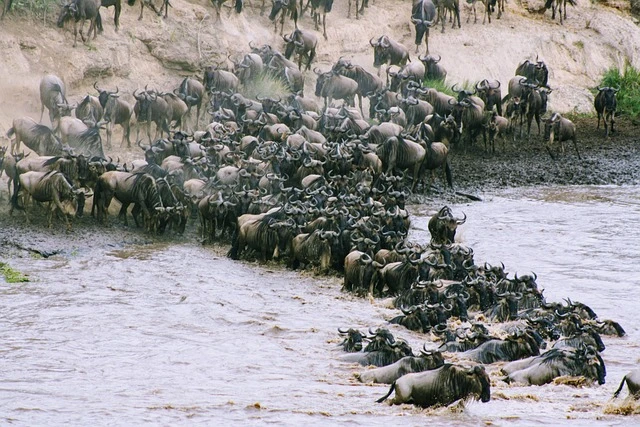
The air is thick with tension as thousands of wildebeests gather at the edge of the Mara River, their eyes wide with fear. The usually calm river now churns with danger, its murky waters hiding the lethal jaws of massive Nile crocodiles, waiting with cold precision. As the first brave animal leaps into the current, a chain reaction ensues—an unstoppable wave of bodies plunging into the river. The water quickly becomes a scene of chaos, thrashing limbs, and desperate cries as the predators strike, dragging their prey into the depths. Blood stains the water, a stark reminder of the brutal reality of the Great Migration.
This is the Great Migration at its most raw and unforgiving—a spectacle of terror and survival where life hangs in the balance. Yet, amidst the bloodshed and the relentless pursuit of safety, there is an undeniable beauty in the sheer scale and power of this natural event. This article takes you into the heart of the migration, exploring the key moments and locations where this drama unfolds. From the perilous crossings at the Mara River to the sprawling plains of the Serengeti and the quieter corners of the Ngorongoro Conservation Area, we’ll guide you through the best places to witness the raw power and awe-inspiring beauty of one of nature’s greatest spectacles.
Yes, you heard that right! AJ Kenya Safaris is thrilled to announce that we are now extending our exceptional safari experiences to the breathtaking landscapes of Tanzania. Building on our reputation for delivering unparalleled luxury holidays across Kenya, we are excited to bring the same level of excellence, personalized service, and deep expertise to Tanzania’s most iconic destinations.
Whether you’re dreaming of witnessing the Great Migration in the northern Serengeti, exploring the vast plains of the Serengeti National Park, or relaxing on the pristine beaches of Zanzibar, AJ Kenya Safaris is here to craft your perfect Tanzanian adventure.
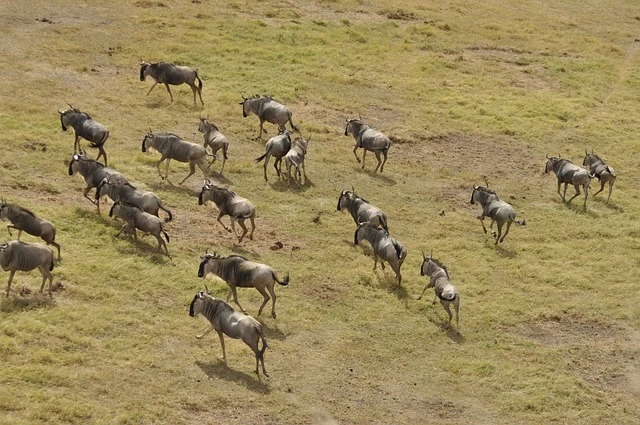
Also known as the Serengeti Wildebeest Migration, the Great Migration is one of nature’s most awe-inspiring spectacles. The migration sees over 1.5 million wildebeests and thousands of zebras and gazelles, embarking on a perilous journey across the Serengeti and Masai Mara ecosystems. This epic annual event is driven by the search for greener pastures and water, as the herds follow the seasonal rains that guide their route.
As they move through the vast savannahs, the animals face numerous dangers, from treacherous river crossings teeming with crocodiles to the ever-present threat of predators like lions and cheetahs. The Great Migration is a dramatic display of survival, showcasing the raw power and beauty of the natural world. For those who witness it, the experience is nothing short of unforgettable, offering a rare glimpse into one of the most extraordinary wildlife phenomena on the planet.
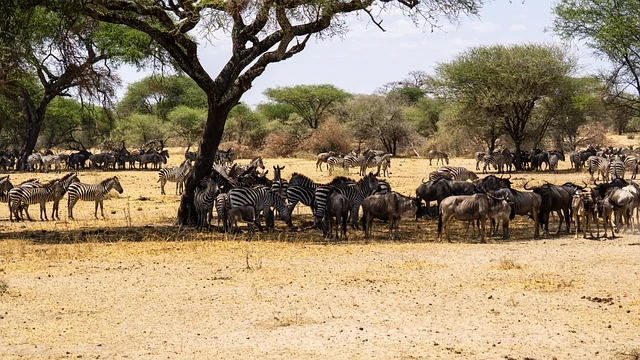
Certain locations are particularly noteworthy for witnessing the Serengeti migration in its full grandeur. The Serengeti National Park in northern Tanzania, especially the serengeti’s western corridor, is perhaps the most iconic, offering vast landscapes where the great wildebeest migration unfolds. This park is central to the migration route, allowing visitors to witness various stages of the journey, from the calving season to the dramatic river crossings.
Another prime location is the Maasai Mara National Reserve in Kenya, best known for the dramatic crossings at the Mara River. Here, the herds face one of the most challenging parts of their journey, as they gather in large numbers along the riverbanks, waiting for the right moment to plunge into the crocodile-infested waters.
Additionally, the Ngorongoro Conservation Area provides unique opportunities to see the migration in a less crowded setting. This UNESCO World Heritage site, located adjacent to the Serengeti, offers a more intimate experience, where the vast landscapes and rich wildlife can be enjoyed without the larger crowds found in more popular areas.
Regardless of the location, mobile camps and strategically planned safaris ensure that you are always in the right place at the right time to witness this natural spectacle.
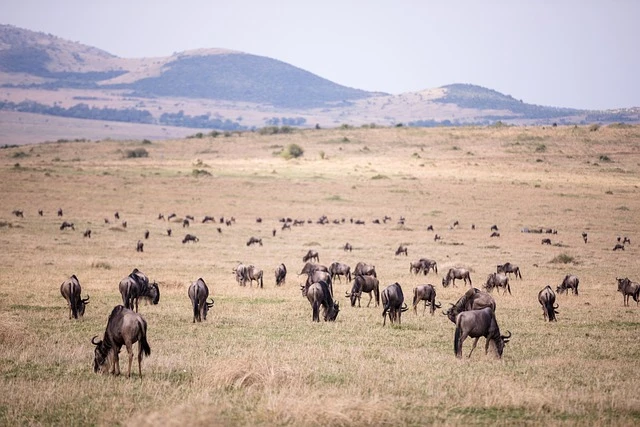
The Great Migration is a year-long adventure that unfolds in a series of phases, each with its own unique events and challenges. This epic journey involves up to two million wildebeest, zebras, and antelopes, breaking up into mega-herds of thousands or even hundreds of individuals. The entire procession is triggered by the onset of rains, marking the beginning of this grand migration safari.
The odyssey commences in early November when short rains lure the herds to the Serengeti’s short-grass plains by late November and December. Throughout the year, the herds traverse various terrains, from the southern Serengeti to the northern Serengeti, near Kenya’s border, constantly in pursuit of fresh grazing grounds. The migration typically spreads over the short-grass plains of the southern Serengeti, Loliondo, and Ngorongoro Conservation Area in March.
This journey can be broken down into four main phases:
Each phase offers unique sightings and experiences, making the Great Migration a year-round spectacle.
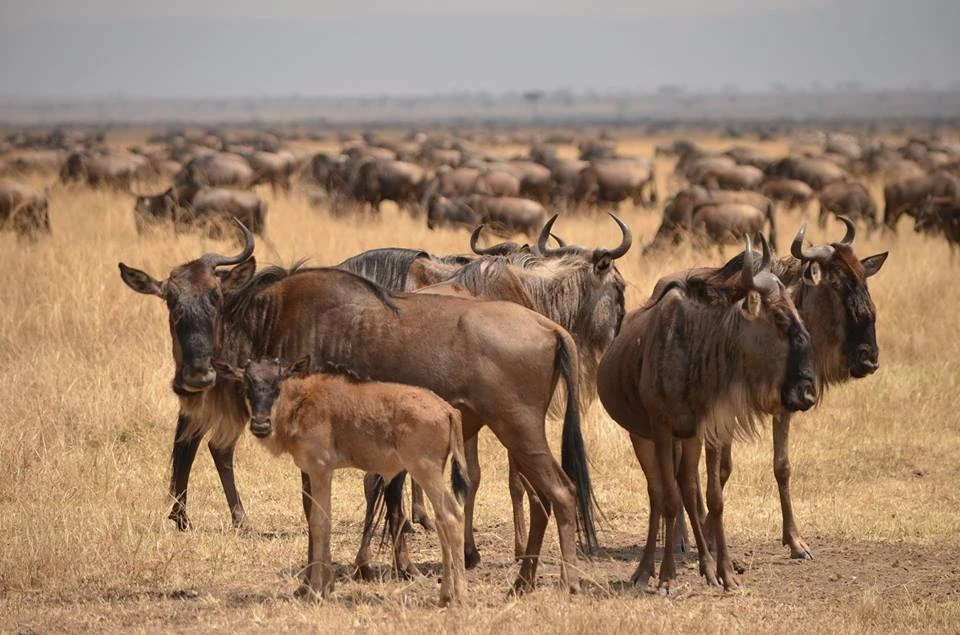
The great wildebeest migration begins in Tanzania’s southern Serengeti, particularly around Ndutu and north of the Ngorongoro Conservation Area. This period is marked by the birth of thousands of wildebeest calves daily, with approximately 400,000 calves born within two to three weeks in February and March. These newborns, remarkably quick to adapt, stand on their feet within minutes of birth, ready to join the migration.
The calving season also attracts numerous predators, making it a prime time for observing predator-prey interactions. Some of the predators that are drawn by the influx of vulnerable young wildebeests include:
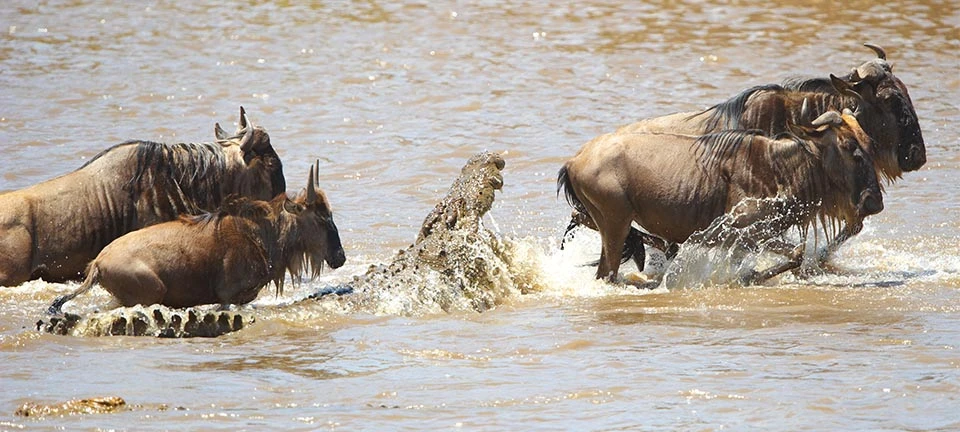
From April to June, the herds begin to move northward, driven by the drying plains. By May, they have reached the central Serengeti, navigating numerous obstacles along the way. Traversing the central Serengeti conditions them for some of the most challenging sections of their migration.
In June, some herds may have already begun crossing the Grumeti River, a perilous part of their journey. The Grumeti Game Reserve offers a quieter experience to witness the migration before the more dramatic Mara River crossings. This phase of the journey is marked by the determination and resilience of the herds as they face both natural and predatory challenges.
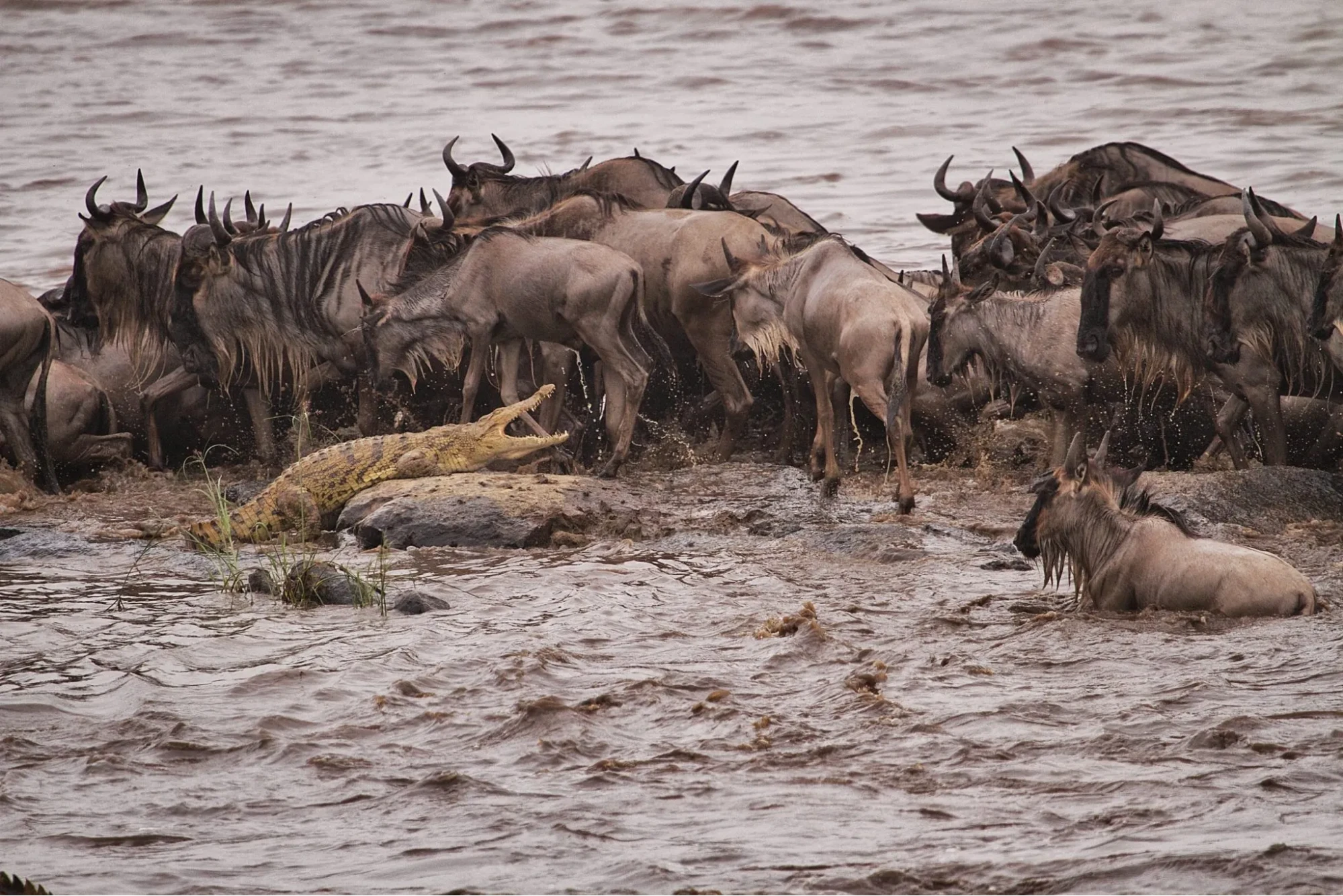
The Mara River crossings, occurring between July and September, are perhaps the most iconic events of the Great Migration. These crossings are fraught with danger, as huge crocodiles lie in wait for the wildebeest herds attempting to cross. The unpredictability of these crossings, with wildebeests often turning away at the last minute due to fear, adds to the excitement and drama.
The Mara River crossings draw large numbers of safari-goers to the Maasai Mara Game Reserve, particularly in August and September. This period is a testament to the survival instincts of the migrating animals as they navigate one of the most treacherous parts of their journey, often under the watchful eyes of fearsome predators.
In October and November, the herds initiate their southward trek back to Tanzania’s Serengeti, drawn by the rains and the allure of fresh pastures. This phase marks the end of their northward journey, with the wildebeests leaving the Masai Mara and heading back into the rejuvenated Serengeti plains.
From December to early March, the herds predominantly populate the southern Serengeti, possibly fragmenting into smaller clusters for their southbound journey. This return phase is a quieter but equally significant part of the migration, as the cycle prepares to start anew with the coming rains.
The Great Migration comprises distinct herds of grazers, each contributing significantly to this natural spectacle.
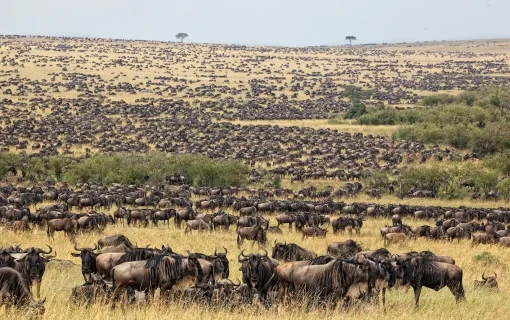
The blue wildebeest, numbering around 1.5 million, forms the backbone of the Great Migration. These resilient animals are believed to navigate their journey by responding to weather patterns, particularly rain and thunderstorms. Their mass movement is a spectacle of nature, as it is the largest mammal migration on the planet.
Their sheer numbers and importance to the ecosystem have earned them a central role in the migration, creating a lifeline for other animals and predators alike. The wildebeests’ journey is not just about survival but also about maintaining the ecological balance of the Serengeti- Mara ecosystem.
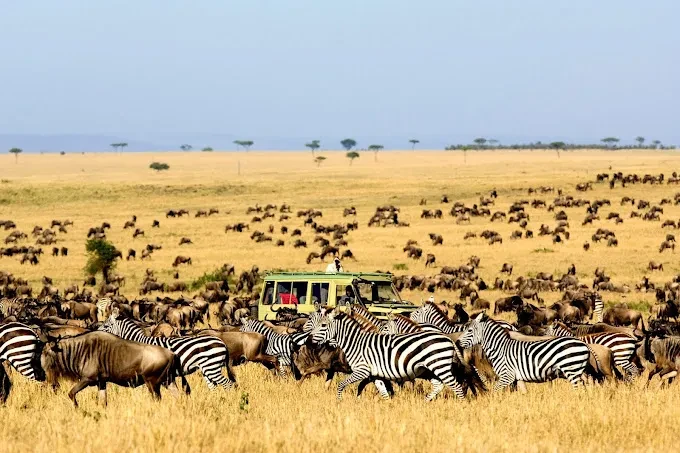
The plains Zebra is an integral part of the Great Migration, with around 200,000 individuals traveling alongside the wildebeests. These animals benefit from the fresh grass that the wildebeests graze upon, often moving in harmony with them. The different grazing habits of zebras and wildebeests allow for efficient use of the available vegetation.
Grant’s zebras, the smallest of the plains zebras, are particularly notable for their distinctive vertical stripes on their bodies and horizontal stripes on their legs. Their presence in the migration adds to the diversity and complexity of this natural spectacle, showcasing the intricate balance of the ecosystem.
Antelopes, though smaller in number compared to wildebeests and zebras, play a significant role in the Great Migration. Their participation adds to the biodiversity of the migration, with species like the Thomson’s gazelle joining the journey. These smaller herds contribute to the overall dynamics of the migration, ensuring a balanced utilization of the Serengeti’s resources.
The Great Migration is more than just a grazers’ journey; it also serves as a hunting territory for some of Africa’s most formidable predators. Lions, hyenas, and crocodiles are the key predators that prey on the migrating animals. During the January and February calving season in the southern Serengeti, predators such as lions, leopards, cheetahs, hyenas, and wild dogs are particularly attracted to the influx of newborn wildebeests.
Throughout the migration, zebras and wildebeests face threats from these predators, creating high drama as thousands of animals are taken by these hunters. The interactions between predators and prey during the migration highlight the brutal yet balanced nature of this ecosystem.
Lions, known for their group hunting and targeting of larger prey like zebras and wildebeests, are among the most daunting predators of Africa’s Great Migration. Lionesses are primarily responsible for hunting, using stealth and patience to get close to their prey before launching an attack. Their ability to remain motionless for extended periods showcases their exceptional hunting skills.
During the calving season, lions take advantage of the abundance of vulnerable young calves, making it a prime time for successful hunts. Their presence adds an element of danger and excitement to the migration, as they play a crucial role in maintaining the balance of the ecosystem.
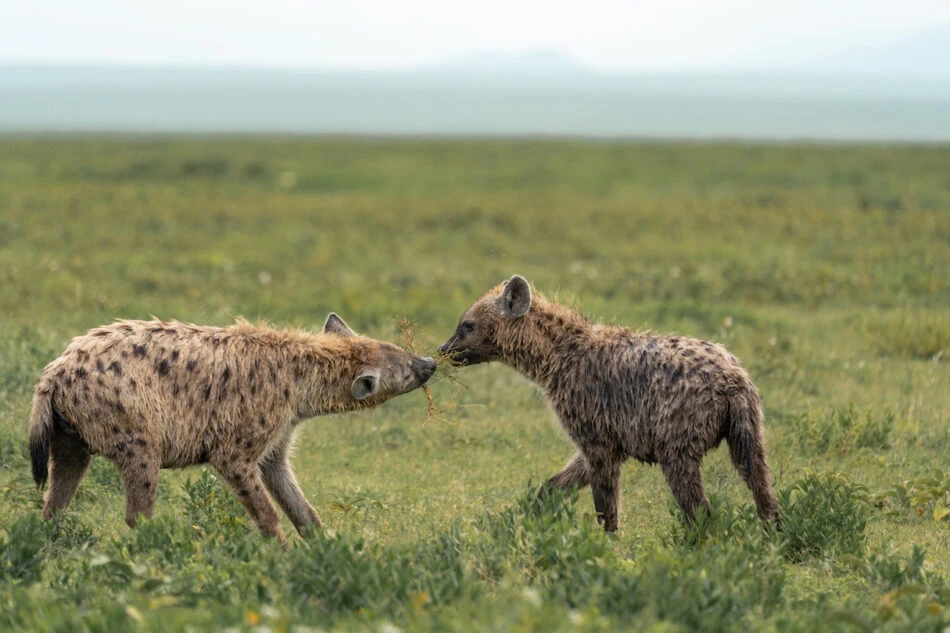
Hyenas, as opportunistic hunters, prey on vulnerable young calves, stalking the migrating herds. Around 7,000 spotted hyenas follow the migration, taking advantage of the chaos and the carcasses left behind by other predators. These scavengers play a crucial role in nutrient recycling, ensuring that no part of a dead animal goes to waste.
The carcasses of animals that do not survive the river crossings provide vital nutrients to the ecosystem, and scavengers like hyenas feast on them. This opportunistic behavior helps maintain the ecological balance during the migration, highlighting the interconnectedness of the Serengeti’s wildlife.
Huge Nile crocodiles, some measuring up to 5 meters in length, lie in wait in the Mara River, ready to attack wildebeests and other animals as they attempt to cross. Crossing the Mara River is one of the most dangerous and dramatic moments of the Great Migration, where the herds must navigate the perilous waters while evading these formidable predators.
The presence of these fearsome predators adds a dramatic and dangerous element to the migration.
Numerous dangers and challenges in the Great Migration test the endurance of the moving animals. Approximately 250,000 wildebeests die each year due to various factors, including:
The larger river crossings, such as the Grumeti and Mara River crossings, are particularly perilous moments for the herds, where they face the dual threats of drowning and predation by crocodiles.
In addition to natural predators, environmental factors play a significant role in the migration’s challenges. The timing and route of the migration are influenced by weather patterns, and the pursuit of grazing grounds and water. Stampedes as the wildebeest migrate can lead to trampling deaths, adding to the already high mortality rate.
Despite these challenges, the Great Migration continues to be a testament to the determination and survival instincts of these incredible animals.
The optimal time to observe the Great Migration primarily hinges on the unique events one aims to witness. For those targeting the river crossings, July and August are considered the best months, with peak viewing occurring from June to September. The chaotic frenzy of river crossings at the Mara and Grumeti Rivers draws many safari-goers during this period.
For those interested in witnessing the calving season and predatory action, February and March are ideal months to visit the southern Serengeti. This period also allows visitors to avoid tourist crowds and observe the birth of thousands of young zebras and wildebeests.
Ultimately, the best time to go on a migration safari depends on the events one wants to see, as the migration is a year-round circular journey with unpredictable river crossings.
Careful planning and early reservations are necessary for a successful Great Migration safari. Given the high demand for lodges and camps during the peak safari season, it is crucial to book at least a year in advance. Choosing a mobile safari camp that moves with the migration ensures that you are in the right place at the right time to witness the various stages of the journey.
Also, tailoring your safari to personal preferences and timing is essential for a fulfilling experience. Consulting with an Africa Safari Expert can help customize your itinerary according to your desired events, budget, and preferences.
Additionally, private conservancies adjoining the Masai Mara National Reserve offer exclusivity, luxurious accommodations, and activities like night drives and bush walks, providing a unique and intimate safari experience.
In summary, the Great Migration is a breathtaking natural phenomenon that showcases the resilience and survival instincts of millions of animals. From the calving season in the southern Serengeti to the dramatic river crossings, each phase of the migration offers unique and unforgettable experiences. Planning your migration safari with careful timing and expert guidance ensures that you witness the best of this epic journey. Embark on this adventure to see the great migration and gain a deeper appreciation for the wonders of the natural world.
In this FAQ section, we address some of the most common inquiries about the awe-inspiring Great Migration
The Great Migration is the largest overland migration on Earth, involving around two million animals moving in a roughly circular path across East Africa, primarily in Serengeti and Maasai Mara.
The best places to witness the Great Migration are Serengeti National Park in Tanzania, Maasai Mara National Reserve in Kenya, and the Ngorongoro Conservation Area, home to the Ngorongoro Crater. Experience this natural phenomenon in these remarkable locations for an unforgettable adventure.
The best time to see the river crossings is from July to September, with the peak season being June to September. Plan your visit during these months for the most dramatic experience.
Around 1.5 million wildebeests participate in the Great Migration, along with hundreds of thousands of zebras and antelopes. This natural spectacle is truly breathtaking.
The main challenges faced during the Great Migration include predation by predators like lions and crocodiles, as well as environmental obstacles such as river crossings, thirst, and hunger. These factors significantly impact the journey of migrating animals